
Sea Surgeon's Dispensatory: 1 2 3 4 5 6 7 8 9 10 11 12 13 14 15 16 17 18 19 20 21 22 23 24 25 Next>>
The Sea Surgeon's Dispensatory, Page 10
Medicinal Books Used: Thomas Brugis’ Vade mecum, or A companion for a chirurgeon (1651)
Thomas Brugis' book Vade mecum, or A Companion for a chirurgeon 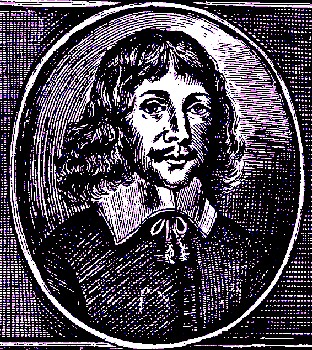
Author Thomas Brugis (1689)
was first published in 1651 and subsequently republished with various additions in 1652, 1653, 1657, 1679, 1681, 1689 as well as in German in 1684.1 It was apparently a popular book in the late 17th century based on the frequency of publication.
Brugis was most likely born sometime between 1610 and 1620 given that he was a surgeon during the seven years of the first and second English Civil War (1642–1649). He never says which side he fought on, although it was likely on the King's side, "for he dedicates his Vade Mecum to William, Earl of Devonshire, who had been a prominent Royalist.”2
Although it is not known from where, he obtained his Doctor of Physick (medicine) and settled in Rickmansworth, Hertfordshire.3 His first book The Marrow of Physicke appeared in 1640 and was reprinted in 1669. This was followed by Vade mecum.
Brugis' writing style is "not very elegant"4 and "there is nothing original in this or in the earlier work."5 Brugis himself laments, "It doth not a little trouble me, that Nature hath been no more liberal to me in terms of Expression."6 However, his advice is straightforward and fairly easy to follow. Brugis explains in The Marrow of Physick, "I have shewed the manner of making and compounding all such medicaments (as wil be
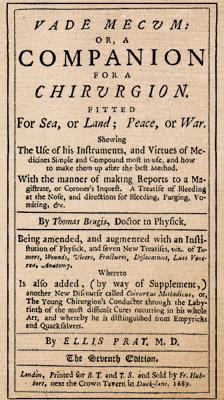
Thomas Brugis' Vade mecum (1689)
usefull in a private house) with the nature and vertue of every receipt, which those that have formerly published some of these have failed to do"7.
His medicinal descriptions in Vade mecum are short, to the point and highly derivative of Woodall's comments. He sometimes includes information Woodall does not, such as dosage and the humoral properties of medicines.
It is notable that on Brugis' title page he proclaims his book is "For Sea, or Land", making it sound as if the medicines in his book are targeted at sea and military surgeons. In a similar way, the title page of the 1674 edition of military surgeon William Fabry's Cista Militaris, or A Military Chest proclaims that it is "Furnished Either for Sea, or Land".
This suggests a belief that medicinal needs of land- and sea-based surgeons were similar - if not the same. In fact, when John Woodall was placed in charge of the medicine chest for England in 1626, he stocked them for both the Army and Navy.8
However, the medicinal needs of a sea surgeon would have differed from those of a land-based military surgeon. The sea surgeon had two conflicting needs in this area: 1. To carry with him all the medicines he would need for weeks and possibly months at a time and 2. To take the minimum possible amount of materials to conserve space and weight on the ship. A land-based military surgeon would primarily be concerned only with weight and, to a lesser degree, space.
Brugis' book lists 217 simple medicines and 202 compound medicines for a total of 4199 - significantly more than Woodall's 284 medicines. Fabry's book is less, but still suggests a notable 321 medicinals.10
So Brugis' book cannot really be looked upon as a reliable indicator of what would be needed in a medicine chest for use at sea. As a result, it is used here only as a descriptive reference for the medicines found the documents written by Woodall, Moyle and Tweedy.
1 Gathered from Worldcat search, 5/12/15; 2 "Retrospective Review: A Physician of the Seventeenth Century: Thomas Brugis’s ‘Vade mecum’ (1651)", The Gentleman’s Magazine, Vol. CCCII, January to June 1907, p. 178; 3 Joseph Frank Payne, “Brugis, Thomas”, Dictionary of National Biography, 1885-1900, Vol. 7, p. 140; 4 "Retrospective Review", p. 181; 5 Payne, p. 140-1; 6 "Retrospective Review", p. 181; 7 Thomas Brugis, "The Preface to the Reader", The Marrow of Physicke, 1669, not paginated; 8 Duane A. Cline, "John Woodall (1570-1643)", www.rootsweb.ancestry.com, gathered 5/11/15; 9 Gathered from Thomas Brugis, Vade mecum: or, A Companion For a Chirurgion", 1689, pp.12-171; 10 Guliielm. Fabritius Hildanus aka. William Fabry. Cista Militaris, Or, A Military Chest, Furnished Either for Sea or Land, p. 13-21
Medicinal Books Used: John Woodall’s The Surgions Mate (1617)
"Woodall's great contribution to maritime medicine was the publication in 1617 of The Surgions Mate, a textbook for 'the benefit of young sea-surgeons employed in the East India Company's affairs' in which he distilled his experience and which was to become the standard reference work for the next half century and went through a number of editions, though the fact that relatively few copies survive suggests that they were much used at sea. It also gave a model for future manuals for the ship's doctor." (Kevin Brown, Poxed and Scurvied: The Story of Sickness and Health at Sea, 2011, p. 37)
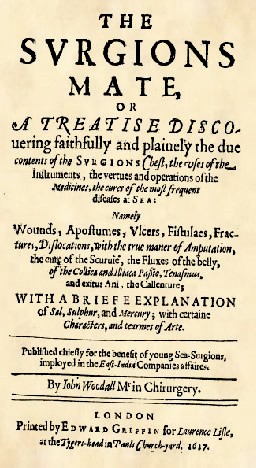
Woodall's the surgions mate (1617)
John Woodall's The Surgions Mate was first published in 1617 and republished with changes and additions in 1639 and 1655. Woodall refers to the 1639 book as "being now the third Edition as it were"1 suggesting there was another edition between 1617 and 1639. This may refer to the publication of Woodall's Viaticum: The Pathway to the Surgions Chest in 1628. Viaticum is a short book which focuses on gunshot wounds - hardly a second edition of his master work. The second edition could also refer to a second printing of the 1617 edition without changes to the publication date to be inserted into his medicine chests. No extant edition of the work has yet appeared between 1617 and 1639, so it cannot be said for certain.
In "The Epistle Dedicatorie" of his book, Woodall explains that he wrote the book for the sea surgeon's younger assistants (referred to at this time as 'surgeon's mates') "to give some directions for the weaker sort of such Surgions, that they may the better be able to undertake their charge, and also to understand the true contents of their [surgeon's instrument and medicine] Chests, and profitably to practice as occasion shal require."2
In a more personal vein, Woodall admits that the book is "to instruct such young men as were imployed in the East Indies... for Conscience sake, and for the comforts of their charge... and being weiried with writing for every shippe the same instructions a new, I held it my best course to put them in print which done, will serve for any that have occasion of the like, till some of deeper judgement write better."3
With regard to medicines, Woodall advises his readers that one of their duties is to note
what hath beene applied either inwardly or outwardly, what operation the medicine had, and so of every diseased person, and every medicine given, and to keepe a Jornall in writing of the daily passages of the voiage in that kinde, and that as well of the unsuccessive [unsuccessful] applications, as of the successive [successful], he shall finde great benefit in both: Likewise what alterations of operations he findeth in each medicine, and what medicines keepe their force longest, & what perish soonest. Also what variety the climate causeth, of the Doses as well of the laxative as opiate Medicines.4
He further urged his charges to continue their education by reading books on "Chirurgery and Phisicke
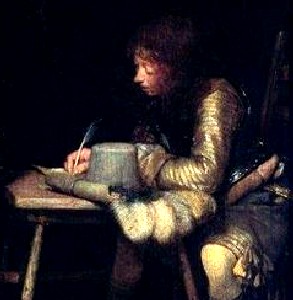
Artist: Gerard ter Borch - Man Writing (1657-8)
[medicines and medicine theory]... as he hath neede of the helpe of his bookes hee may againe finde the thing he once read, it will turne much to his profit"5.
Woodall believed strongly in the importance of medicines. "Each man will conceive that medicine is a principall part of healing and curing of sores, diseases, and sicknesses: for who is hee that can cure a wound, a tumor, an ulcer, yea, but an ague with his hand only, without fitting medicines? Surely no man"6.
As noted earlier, about 47% of the main text of his book deals directly with medicines. The bulk of this is found on pages 40 through 124 which is similar in form to the dispensatories written by private authors, although Woodall does not include descriptions of how the medicines would be made. (Since this involved extracting and compounding medicines, distillation and other precision operations which would be difficult at sea, explanations of these processes would have been superfluous to the average sea surgeon.)
Woodall also has special sections in his book for specific medicines including laudanum pills (pp. 224-32), salts & chemical medicines (pp. 250- 291 - note that this section skips pages 251-270 due to mistaken pagination so it really only contains 22 pages), sulphurs (pp. 292 - 6), mercury (pp. 297 - 307), the symbols for medicines with comments on their properties (pp. 313-28) and a poem titled "Certain Chemical Verses, Or God will to young Artists, from the Atuhor [sic]" (pp. 329-37). Most of the latter sections deal with chemical medicines and Paracelsian ideas.
In addition, Woodall discusses different types of medicines while describing operations and cures. These are not included here. If they were, more than half his book could be said to consist of medicinal instructions.
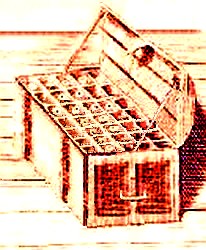
Artist: John Nicholls
Medicine Chest, From The Quack
Doctor Outwitted (1710)
Between the 1617 and 1639 editions of the surgions mate, we find descriptions of 299 total medicines. If all of these medicines were stored in his medicine chest, it would be "evidence of the massive size of his chest"7. However, his diagram of the placement of medicines in the chest only contains slots for 160 medicines. Of these, there are only 124 distinct medicines; the rest are duplicates. (These medicines and their location in the medicine chest are detailed in the article John Woodall's Medicine Chest Ingredients.)
Woodall's diagram explains "that the particulars [specific medicines] mentioned on each side of this place, are usually to be found in the upper part of the Chest. The middle part, which cannot bee here expressed, I leave to the Surgeons experimentall ordering and view."8 This makes it sound as if he stored 158 medicines in a spot that looks as though it might hold a couple dozen at most.
However, Woodall doesn't actually say that all the medicines he discusses should be included in the surgeon's chest. As we saw when he discussed the properties of three opiates - Philonium Romanum, Philonium Persicum and Philonium Tarsens - Woodall advised that they not be included in the chest "because they will not keepe an East India voyage, and Laudanum opiate paracelsi is sufficient for ought [anything] the other[s] can doe."9 So it is only certain that the medicines specifically shown in his diagram of the medicine chest were included in it. The rest may or may not have been there. With this in mind, the Sea-Surgeon's Dispensatory will indicate whether or not a medicine mentioned by Woodall was specifically shown in his medicine chest.
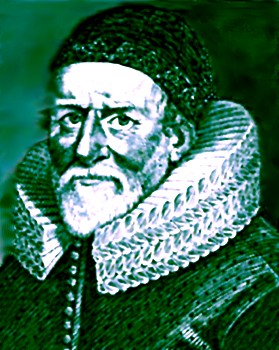
John Woodall (1617)
John Woodall was born in Warwick around 1570, the son of Richard and Mary Woodall. Woodall was apprenticed to a London barber-surgeon at the age of 16 or 17.10 He was with Lord Willoughby's regiment in Normandy in 1589-9011, evidence that he did not actually complete a full seven year surgical apprenticeship.
Woodall did not return to England with Willoughby's troops, instead remaining to act as surgeon to a colony of English merchants at Strodda, Germany, near Poland. He lived there for eight years.12 Woodall also visited Holland at some time after that, lodging and working with a Dutch apothecary who made counterfeit medicines.13
Woodall returned to London via France in 1599 and was admitted as a as a freeman of the Barber-Surgeon's Company.14 He spent the next several years learning his trade. In 1604, Woodall was sent as part of an embassy to Poland where he worked with Sir Thomas Smythe, Governor of the East Indian Company by King James I.15 Based on information in his books, he also appears to have been a sea surgeon in the ensuing years, probably travelling to the East Indies.16
In 1613 Sir Thomas Smythe appointed Woodall
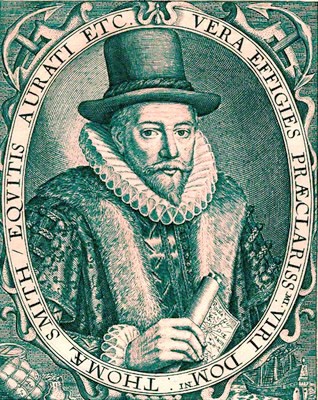
Sir Thomas Smythe (1616)
the first Surgeon-general to the East India Company. "For the first time, an office was established to help solve the administrative issues present in the coordinated delivery of health care to a population."17 As 'Chirurgion generall' of the East Indian Company, Woodall (and his deputy) had a "Lodging or place in the Yard" where they were to attend to the needs of "any person or persons who may be hurt in the Service of this Company, and the like in all their Ships riding at an Anchor in Deptford and Blackwall, or at Erith, where hee shall also keepe a Deputy with his [surgeon's] Chest furnished, to remaine there continually, untill all the said Ships be vayled [sailed?] downe from thence to Gravesend."18 He was to perform barbering on the "Carpenters, Saylors, Caulkers, Labourers, & any other Workemen in the Companies said Yards, and Ships, once every forty dayes"19.
An important part of Woodall's job was also to "furnish up all the said [medicine and surgeon's] Chests"20. This lead to his redesign of the company's surgeon's chests as well as the creation of a system for checking the medicines and sealing them to indicate that they were properly supplied for the voyage.21 This gave Woodall a monopoly on supply of surgical chests to the East Indian Company, assuring his financial future.
His work in this area caught the attention of the government as well. 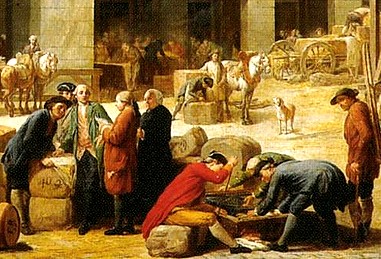
Artist: Nicolas Bernard Lepicie (1775)
The Barber-Surgeon's Company to which he belonged was asked to make up the medicine chest for the Army and Navy in 1626. They turned to Woodall who had "charge of pressing, furnishing, and ordering of his Highnesse whole Navie and land services, with Surgeons and Surgeons Mates, with all their provisions."22 Kevin Brown notes that "even after his dismissal by the East India Company in 1635, he retained his monopoly over the supply of surgeons' chests to the [East India] Company until his death in 1643."23
Part of Woodall's job as "Churgion generall" of the Company was also to "acquaint and shew them [the ship's surgeons] from time to time, all such Medicines and things as shall be furnished into the [surgical and medicine] Chests"24. It was this duty that led to his writing The Surgions Mate, firmly establishing Woodall's place in history.
Woodall had a number of accomplishments to his credit outside his job with the East Indian Company. He was appointed Surgeon to St Bartholomew’s Hospital in 1616, made the Barber-Surgeon’s Company examiner in 1626, Warden in 1627 and Master in 1633.25
Woodall was also credited with the invention of two medical tools - the spatula mundani and the T-shaped trepan.
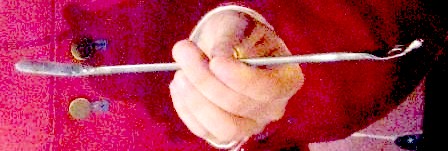
The Author's Spatula Mundani
The spatula mundani was a double-ended tool about 12 inches long. One end consisted of a flat spatula for mixing and applying medicines. The other end was spoon-shaped with a knob on the end and a hole in the bottom of the spoon, which was to be used, "if occasion urge, [the anus] is to be opened, and the spoone end of this instrument put in, and the hard
excrements therewith drawne out; which in some bodies are so drie
that they may be poudered."26
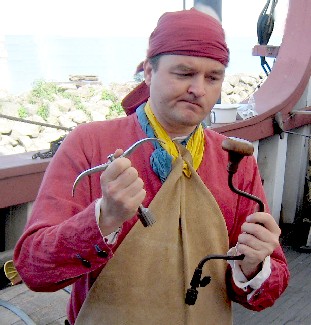
The Author Considers the Trefine (l) and Trepan (r)
The T-Shaped trepan was called by Woodall a trefine in his instrument list27 and a trafine elsewhere, "it being an Instrument of my own composing, which experience will shew, is more compendious, and of more facility in the use thereof, for young practitioners in Surgery then is the Trapan [trepan]"28. Woodall further explained, "I thought fit to put the name of Trafine upon it (a tribus finibus [three-ended]) from the three ends thereof, each being of several uses"29.
His design incorporates two levatories in the handle, which are curved instruments used to 'levitate' or pry up a depressed skull. Woodall points out that a regular (brace-handled) trepan requires "a second man for an assistant of necessity, that must be imployed to stay [hold] the Patients head" because the surgeon must put one hand on the top of the brace trepan and use his other hand to rotate it. However, with his trafine "the whole worke is performed by the two hands of the Surgeon onely, with farre more dexterity and quicker, then with the Trapan"30 because the surgeon only needs to one hand to operate the tool, allowing him to use the other to steady the patient's head. Very clever, our Mr. Woodall.
1 John Woodall, "Preface", The surgions mate, 1639, not paginated; 2 Woodall, "The Epistle Dedicatorie", the surgions mate, 1617, not paginated; 3 John Woodall, "To the Reader", the surgions mate, 1617, not paginated; 4,5 John Woodall, "The office and dutie of the ", the surgions mate, 1617, not paginated; 6 Woodall, "Preface", The surgions mate, 1639, not paginated; 7 Joan Druett, Rough Medicine: Surgeons at Sea in the Age of Sail, 2000, p. 52; 8 John Woodall, the surgions mate, 1639, diagram opp. page 26; 9 Woodall, the surgions mate, 1617, p. 88; 10 "John Woodall. 1570–1643", British Journal of Surgery, Volume 4, Issue 15, 1910, p. 369; 11 Duane A. Cline, "John Woodall (1570-1643)", www.rootsweb.ancestry.com, gathered 5/11/15; 12 "John Woodall. 1570–1643", British Journal of Surgery, p. 369; 13 Glen Hazelwood, "John Woodall: From Barber-Surgeon to Surgeon-General," Proceedings of the 12th Annual History of Medicine Days, March 2003, p. 118; 14 Cline, gathered 5/11/15; 15 Rory W. McCreadie, The Barber Surgeon's Mate of the 16th and 17th Century, p. 37; 16 Druett, p. 14; 17 Hazelwood, p. 119; 18 The Lawes or Standing Orders of the East India Company, 1621, p. 32; 19,20 The Lawes or Standing Orders of the East India Company, p. 33; 21 Hazelwood, p. 120; 22 Woodall, 1639, not paginated; 23 Kevin Brown, Poxed and Scurvied: The Story of Sickness and Health at Sea, 2011, p. 37; 24 The Lawes or Standing Orders of the East India Company, p. 33; 25 McCreadie, p. 37; 26 Woodall, 1639, p. 9; 27,28,29 Woodall, 1639, p. 313; 30 Woodall, 1639, p. 314
Medicinal Books Used: John Moyle’s Churgius Marinus, or The Sea Surgeon (1693)
John Moyle's book first appeared as Abstractum Chirurgiæ Marinæ Or, An Abstract of Sea Chirurgery in 1686. A second edition of this work appears to have been released in 1689.1 Moyle greatly added to and revised the material in Abstractum, publishing it as Churgius Marinus, or The Sea Surgeon in 1693. A "Fourth Edition, newly Corrected and Inlarged, with several useful Additions" was released in 1702.2
Of Moyle's writing style,
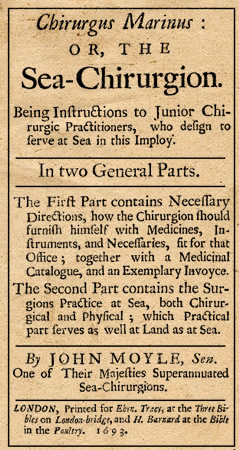
Moyle's Chirurgus Marinus (1693)
the British Journal of Surgery says he was "a capable and practical surgeon, devoid of imagination, and intent only on describing what should be done under the conditions of naval service to which he had been accustomed."3 Historian John Keevil explains that he was "Less learned than [sea surgeon James] Yonge and less polished than [military surgeon Richard] Wiseman", having "none of the critical scientific attitude of these men."4
However, Keevil goes on to say that Moyle "provided in handbook form all that ships’ surgeons so much needed to know when they found themselves faced for the first time with unfamiliar conditions; and since neither naval conditions nor medical practice changed greatly until the age of steam and iron, the value of his textbook outlived its author by more than a century. It has no equivalent today."5 Moyle's manual is certainly the most readable sea surgeon's tome from the period and his commentary is pithy, direct and includes a variety of informative case studies.
With the publication of Chirurgus Marinus, Moyle added "The Exemplary Invoyce" which included 152 medicinals6. This is about half of the number of medicines that Woodall discusses.
Moyle advises that his list is incomplete, however. Rather than include medicines that may be used but which he does not necessarily recommend, Moyle only gives what he feels are the core medicines. As he explains in his comments on the 'Invoyce', it "is not intended to impose upon you to carry, or practice with them very Medicines, and no others (you are at your own choice as to that) but it is to shew you how to form an Invoyce, as all other Sea-Chirurgions do, to fit their Chests by, yet it shall be of the very flower of Medicines (as near as I can) and such as all (or most) Chirurgions in England do make use of (especially Sea-Chirurgions)."7 Here again we see his practical turn of mind.
Of Moyle's 152 medicines, 85 are shared in common with John Woodall's list and 46 appear in John Tweedy's list. (Only 32 of the medicines are included by all three sea surgeons.) This leaves a notable 61 medicines unique to Moyle in his list.
This begs the question of whether medicines used by sea surgeons changed a great deal between 1655 (the last printing of Woodall's the surgions mate) and 1693 or if each surgeon just followed their own ideas about what medicines were most effective. Given the variety of medicines recommended by surgical authors at this time, it seems more likely that they were simply following their own instincts based on what they had seen work in the field.
Although Moyle does not describe any of the standard medicines in his book, he includes detailed prescriptions for 34 compound medicines. (These are not included in the above calculations.) In his usual style, they are simply titled (although usually in Latin) with their names suggesting their purpose: Defensivum magnum, Decoctum Emollins, Potus Apertiv and Traumatic Powder. He puts these at the beginning of his book, "to save the trouble of writing one thing often, and avoid tedious tautology [saying the same thing in different ways]"8. Moyle explains that these compounds include medicines "that are used by all Sea Surgeons... [along with] some choice Receipts of soveraign Balsams of my own"9. The 29 of these 34 compounds that have detailed instructions for preparation are included in our Sea Surgeon's Dispensatory .
Of Moyle himself, we only know about his life from what he wrote in his books. His date and location of birth are unknown along with the details of his education. He served with the Royal Navy, although he doesn't mention the particular ships he had been on or battles he had been in. He does mention his participation in ‘the last Holland war’, in 1673; as well as actions that took place "before Tripoli
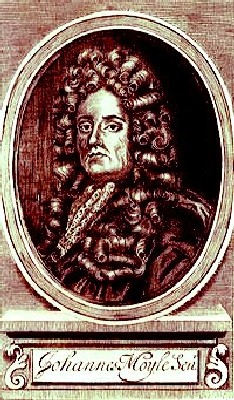
John Moyle (1693
in Barbary, when we had wars with that place’—that is, in 1676."10 He also discusses having been in Newfoundland, at several places in the Mediterranean; Alexandria, Scanderoon, Smyrna, and Constantinople.11
Moyle appears to have been a popular surgeon amongst his charges, receiving plaudits from the sailors aboard at least one ship on which he sailed in 1680:
We the mariners belonging to His Majesty's Ship James Galley have many of us been desperately sick of malignant fevers and fluxes, and by the scurvy, an others of the crew were wounded and bruised by accidents aboard the same ship but all of us and many more have been safely cured again by the care and skill of our chirurgion in Mr John Moyle who hath... sufficiently proved himself both a very able surgeon and an honest man by his behaviour, hath been so civil towards all men that he hath an extraordinary respect from the ship's company in general.12
Moyle was retired by the Navy "about 1690 on a pension of apparently 40l. {40 pounds} a year, and applied himself in his old age to writing his surgical experiences for the benefit of younger sea-surgeons."13 In addition to his sea surgeon's manual, he wrote The Experienced Chirurgeon in 1703, which discussed cures for various illnesses. He also published Chirurgic Memoirs in 1708, which contained case studies from his practice. He appears to have lived out his remaining years in Westminster. dying in February of 1714. "He left a widow, Mary, and three children, a son, John, and two daughters, Mary Nozet, and Susanna Willon, apparently by a former marriage."14
1 Based on Worldcat search, 5/12/15; 2 John Moyle, The Sea Chirurgeon, 1702, title page; 3 "John Moyle. One of Her Majesties Ancient Sea-Chirurgeons", British Journal of Surgery, Vol. 3, Iss. 12, 1915, p 586; 4,5 John J. Keevil, Medicine and the Navy 1200-1900: Volume II – 1640-1714, p. 157; 6 Gathered from John Moyle, The Sea Chirurgeon, 1693, pp. 30-35; 7 Moyle,1693, p. 29; 8 Moyle,1693, p. 9; 9 Moyle,1693, p. 10; 10,11 John Knox Laughton, "Moyle, John (d.1714)", Dictionary of National Biography, 1885-1900, Volume 39, p. 244; 12 Kevin Brown, Poxed and Scurvied: The Story of Sickness and Health at Sea, 2011, p. 49; 13,14 Laughton, p. 244
Medicinal Books Used: John Tweedy’s Bill of Medicines for surgeon Nicholas Holmes of the Privateer Sloop Revenge
The last list of medicines used in the Sea Surgeon's Dispensatory
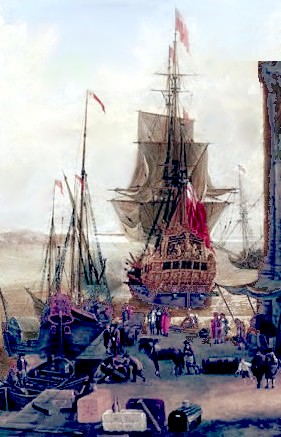
Artist: Jacob Knyff
English and Dutch Ships Taking on Stores in Port (1673)
comes from a document rather than a book. It is a bill of sale for medicines delivered to the surgeon Nicholas Holmes of the privateer sloop Revenge in Newport, Rhode Island by Apothecary John Tweedy in November of 1743. This is included with a variety of other documents concerning the privateer by the Massachusetts Historical Society. The editor of the book in which it appears notes that the list is "a typical outfit of medical and surgical supplies for a privateer"1.
Tweedy's document is unique among the three documents used to create the Sea Surgeon's Dispensatory in that it contains both the quantity and price of each medicine. (This makes sense given that it is a bill of sale.)
The list includes 118 total medicines2, 47 of which are unique to Tweedy's list. Of the remaining 71 medicines, 57 are shared by Woodall and 46 are shared by Moyle. (As noted previously, all three list 32 medicines in common.)
It is worth noting that this was not the first voyage of the Revenge under Captain Benjamin Norton and the medicine chest from the previous voyage may (or may not) have still contained some medicines from her previous voyages. So, like the others, this list cannot be said to be a full and complete listing of all the medicines found in this privateering ship, the book editor's comments notwithstanding. Even if it is not complete, it suggests which of the medicines were most used on the previous voyage.
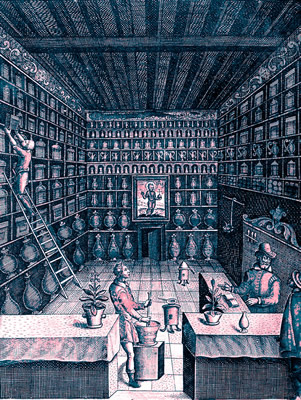
Interior of an Apothecary Shop (1608)
From the Wellcome Image Collection
The cost of medicines is mentioned repeatedly in the documents concerning the Revenge and are worth mentioning here. When Captain Norton hired another surgeon, William Blake in July of 1741, the captain returned to the ship and "brought with him a Chest of Medicines, a Doctor's Box which Cost £20 [New] York Cur[renc]y"3. The next day, merchant Isaac van Dam delivered "an Acct. of the Doctors Chest and other things found for him which Amounts to £38.2.1 New York Currency"4. Why two different costs for the chest are included is not entirely clear from this account. However, since Vezian shows £38.2.1 New York currency as the price of the chest in his 'Account of the Charges', that is likely the correct amount. In his account, Vezian converts the New York currency to Rhode Island currency, coming up with £114.6.3.5
Two years later, Tweedy's 1743 bill for medicines for Nicholas Holmes came to £130.2.9 (Rhode Island currency).6 In yet another account for the Revenge for June of 1744, the account lists "Tweedy [June] 15th. To the Docters Chest" at £165.0.0.7 Why these amounts differ is not explained. It could be due in part to inflation in the costs of medicines, differences between New York and Rhode Island currencies and costs or variance is the amount and types of medicines purchased.
Of ship's surgeon Nicholas Holmes, nothing is known other than his name. However, we have some details about John Tweedy, the apothecary in Newport. He was born in 1706. Where and how he
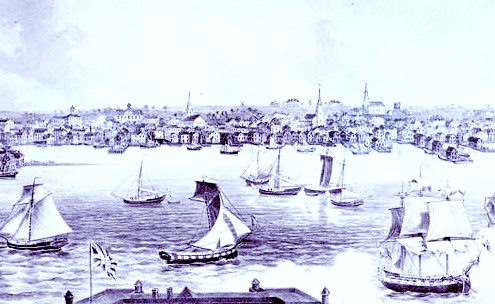
The Port in Newport, Rhode Island in 1730
was educated is not known, although his grave refers to him as "Dr". He married Marcy Tillinghast in 1732, who died three years later. He then married Freelove Sophia Crawford in 1735.8
Tweedy had a shop in Newport, Rhode Island for at least 25 years. The first appearance I find of him as an apothecary is in 1738 when he filled an order for laudanum for Mary Ward.9 He published the first known catalog of drugs in 1760 which he sold "at his shop in Newport, Rhode Island, and for him [at the shop] in New York at the sign of the Unicorn and Mortar."10 This catalog appeared again in 1763.11
His son William appears to have joined him in the trade at some point as Edith May Tilley reported that “John and William Tweedy were the largest importers of drugs in the American Colonies.”12 John Tweedy was a member of Trinity Church in Newport with a pew dedicated to him in 176213. He also became a member of the American Philosophical Society in June of 1768.14 Tweedy died in November of 1787.15
1 The reader should note that this document was written 16 years after the end of the golden age of piracy as it is defined on this website.2 Gathered from "158. John Tweedy’s Bill for Medicines. November 8, 1743". Privateering and Piracy in the Colonial Period Illustrative Documents, John Franklin Jameson, ed.,1923, p. 457-61; 3,4 Peter Vezian, “145. Journal of the Sloop Revenge. June 5-October 5, 1741”, Privateering and Piracy in the Colonial Period, John Franklin Jameson, ed., 1923, p. 391; 5 Vezian, p. 393; 6 "158. John Tweedy’s Bill for Medicines. November 8, 1743", pp. 461; 7 “159. Account for the Revenge. June, 1744”, Privateering and Piracy in the Colonial Period, John Franklin Jameson, ed., 1923, p. 462; 8 "Dr John Tweedy" findagrave.com, gathered 5/13/15; 9 David Chacko & Alexander Kulcsar, Beggarman, Spy, 2010, p. 154; 10 Library of the Surgeon-General's Office, Index-catalogue of the Library of the Surgeon-General's Office, United States Army: Authors and subjects, Vol. 14, 1890, p. 910; 11 Library of the Surgeon-General's Office, Index-catalogue of the Library of the Surgeon-General's Office, United States Army: Authors and subjects, Second Series, Vol. 4, 1899, p. 514; 12 Edith May Tilley, Historic Spots in Newport, 1914, p. 18; 13 George Champlin Mason, Annals of Trinity Church, Newport, Rhode Island, 1890, Volume 1, p. 128; 14 "List of the Member of the American hilosophical Society", Proceedings of the American Philosophical Society held at Philadelphia for promoting useful knowledge, Vol. XVIII, July 1878 to March 1890, 1880, p. 8; 15 "Dr John Tweedy" findagrave.com, gathered 5/13/15;

